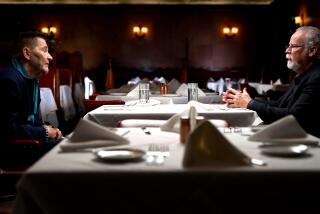‘Twilight’ Jury Sees Film of Copter Crash : Attorneys on Both Sides Agree Footage Will Have Impact on Panel
- Share via
Jurors in the “Twilight Zone” trial took a highly unusual field trip to a posh Beverly Hills theater Wednesday to view Exhibits 15, 16 and 17--the footage of the gruesome helicopter accident in which actor Vic Morrow and two child actors perished on a film set in 1982.
Seated silently along with Los Angeles Superior Court Judge Roger Boren, who was garbed in his black robe despite the odd surroundings, the jury twice viewed 28 minutes of outtakes shot from six camera angles in the darkened theater of the Academy of Motion Picture Arts and Sciences.
After the second showing, the 12 jurors and four alternates somberly filed outside to a Sheriff’s Department bus to return to the downtown Criminal Courts Building, where film director John Landis and four associates are in their fourth week of trial on involuntary manslaughter charges.
The five defendants, who also attended the screening, are accused of criminal negligence and child endangerment in the deaths of Morrow, 53; Renee Chen, 6, and Myca Dinh Le, 7. The actors were killed when a helicopter crashed amid special-effects explosions during the shooting of a Vietnam War battle sequence.
After the screening session, attorneys for both sides voiced rare agreement that the footage will have an impact on the jurors, although they continued to disagree on their interpretations of the vivid footage.
“The jurors are supposed to not make up their minds until they’ve heard all the evidence,” Deputy Dist. Atty. Lea Purwin D’Agostino said. “But you can’t not see what you’ve seen. They’ve just seen three people killed. For what? For a lousy movie.”
Said Landis’ co-counsel James Sanders: “Your imagination tends to fill in the void. . . . It’s not until the fourth or fifth time you see it that you start looking for the things we are litigating about.”
While the color footage did not graphically depict the actors’ deaths, it did show the low-flying helicopter spinning crazily out of control toward Morrow, who was standing knee-deep in a river holding the children in his arms. As the churning water cleared, the damaged helicopter lay still in the water. There was no trace of the actors where they had previously stood.
Moments later, Landis, wearing hip waders, was seen rushing into the water toward the helicopter, frantically waving his hands in the air. In the background, a slightly out-of-focus Vietnamese village burned in silence in the pitch black night.
Later, outside the makeshift courtroom, attorneys for both sides maintained that the footage, which the jury is expected to eventually view in slow-motion several times in the downtown courtroom, will buttress their case.
“It was not a very dangerous situation,” James Neal, Landis’ co-counsel, contended to reporters. “It became dangerous, and anything would, when you make a mistake.”
To Neal, the film made clear that two explosions set off by a special-effects employee who was granted immunity by the prosecution were accidently ignited before the helicopter was safely out of the way, thereby causing the accident. Defense attorneys also said the footage that was not included in the final “Twilight Zone” film proved that the fatal scene was adequately rehearsed before it was shot.
“It’s not pretty to see an accident,” Neal said. “But it happened.”
Special Effects
D’Agostino, meanwhile, emphatically countered that the defendants were negligent for not taking into account the possibility that the special effects would misfire.
“There’s nothing unforeseeable about a misfire. . . . It was not an earthquake, it was not an act of God; everything that happened there was created by man,” she said. “. . . When you do things that are dangerous, you have to take into account contingencies.”
D’Agostino, who termed the film “one of the most important pieces of evidence that anyone could ever have in any trial,” added that Landis could have used “dolls or even sacks of potatoes,” rather than people under the helicopter, which was hovering 24 feet in the air.
Landis, she asserted, “was looking for an incredible amount of realism.”
“And he achieved it. But at an incredible cost,” she said.
Landis, accompanied by his wife, left the theater without comment.
Safety Precaution
Although the public was barred from the afternoon screening as a safety precaution, the defendants, attorneys and about 20 news representatives viewed the footage from pre-assigned seats behind the jurors, who sat in the middle of the cavernous theater that seats 1,100.
Last week, defense attorneys had requested that the film be shown instead in the courtroom on a screen or TV monitor, complaining that D’Agostino was “grandstanding” by reserving the academy’s state-of-the-art Samuel Goldwyn Theater.
“You’re going to get into almost a theatrical production,” asserted defense counsel Leonard Levine.
“Well, it was one,” replied Boren, who then ruled that “a professional setting for the film is appropriate.
More to Read
Only good movies
Get the Indie Focus newsletter, Mark Olsen's weekly guide to the world of cinema.
You may occasionally receive promotional content from the Los Angeles Times.










